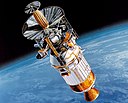Archivo:Galileo launched from Space Shuttle Atlantis (S89-42940).jpg
Apariencia

Tamaño de esta previsualización: 750 × 600 píxeles. Otras resoluciones: 300 × 240 píxeles · 600 × 480 píxeles · 960 × 768 píxeles · 1280 × 1024 píxeles · 2560 × 2048 píxeles · 5364 × 4291 píxeles.
Ver la imagen en su resolución original (5364 × 4291 píxeles; tamaño de archivo: 2,9 MB; tipo MIME: image/jpeg)
Historial del archivo
Haz clic sobre una fecha y hora para ver el archivo tal como apareció en ese momento.
| Fecha y hora | Miniatura | Dimensiones | Usuario | Comentario | |
|---|---|---|---|---|---|
| actual | 05:33 26 may 2020 |  | 5364 × 4291 (2,9 MB) | Huntster | == {{int:filedesc}} == {{Information |Description={{en|1=In this artist's rendition, the Galileo spacecraft is being boosted into its interplanetary trajectory by the Inertial Upper Stage (IUS) rocket. The Space Shuttle Atlantis, which is scheduled to take Galileo and the IUS from Earth's surface into space, is depicted against the curve of Earth. Galileo will be placed on a trajectory to Venus, from which it will return to Earth at a higher velocity and then gain still more energy in two gra... |
Usos del archivo
La siguiente página usa este archivo:



